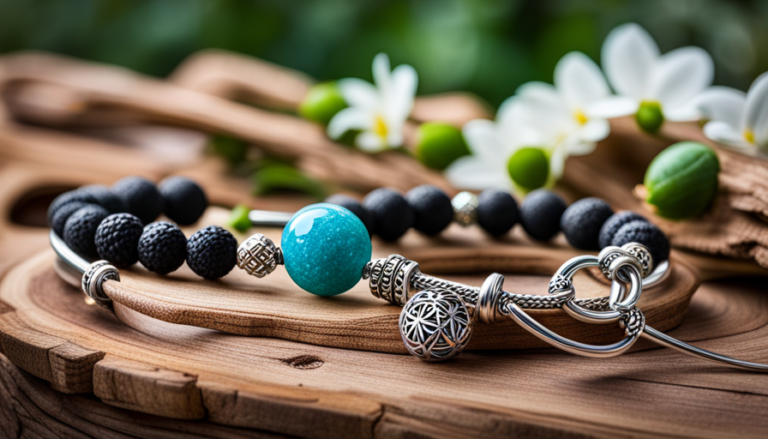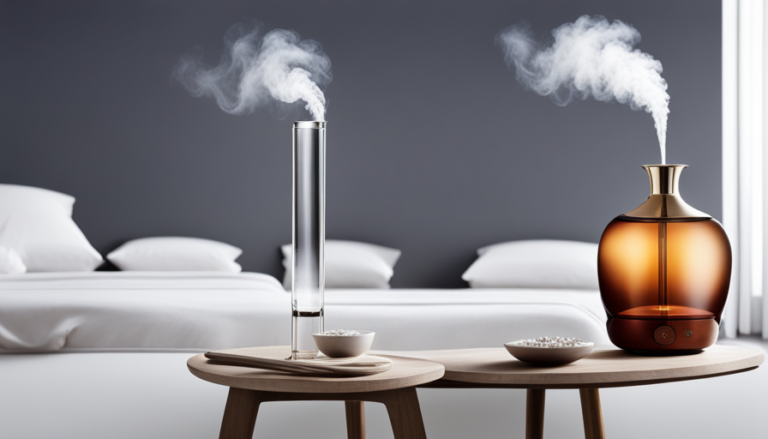Peppermint Essential Oil Blends Well With

Looking for the perfect essential oil blend? Look no further than peppermint. With its invigorating and refreshing scent, peppermint essential oil blends seamlessly with a variety of other oils to create unique and beneficial combinations.
Whether you’re seeking relaxation, respiratory support, or an immune boost, peppermint pairs beautifully with lavender, eucalyptus, lemon, rosemary, and tea tree.
In this article, we’ll explore the science behind these harmonious blends and discover how to harness their therapeutic properties for your well-being. Get ready to dive into the world of aromatic compounds and unlock the potential of peppermint essential oil blends.
Key Takeaways
- Lavender and Peppermint Blend promotes relaxation and stress relief, alleviates tension, and enhances skincare products.
- Eucalyptus and Peppermint Blend uplifts mood, supports respiratory health, helps with muscle soreness, and should not be used on children under six or sensitive skin.
- Lemon and Peppermint Blend provides an invigorating aroma, enhances mood, boosts immune function, and can cause photosensitivity when applied topically.
- Rosemary and Peppermint Blend promotes mental clarity, improves circulation, nourishes the scalp, and adds an earthy note to blends.
- Tea Tree and Peppermint Blend complements aromatherapy blends, enhances well-being, has antibacterial properties, and provides relief from skin conditions and muscle pain.
Lavender
Peppermint essential oil blends well with lavender. Combining these two oils offers a multitude of benefits for relaxation and stress relief. Lavender is known for its calming properties, while peppermint provides a refreshing and invigorating aroma. When used together, they create a harmonious blend that promotes deep relaxation and alleviates tension.
To create a homemade lavender and peppermint essential oil blend for natural skincare products, simply mix equal parts of both oils in a carrier oil such as jojoba or almond oil. This blend can be added to body lotions, creams, or massage oils to soothe the skin and enhance the overall experience with its delightful scent.
The combination of lavender and peppermint essential oils also offers additional benefits beyond relaxation. The aromatic compounds present in these oils stimulate the olfactory system, which helps to reduce anxiety and promote feelings of calmness.
Now let’s explore how eucalyptus blends with peppermint essential oil…
Eucalyptus
You’ll find that eucalyptus pairs beautifully with peppermint in your essential oil blends. When combined, these two oils create a refreshing and invigorating aroma that can uplift your mood and clear your mind.
The aromatic compounds found in eucalyptus essential oil, such as 1,8-cineole, contribute to its therapeutic properties, including its ability to support respiratory health and promote mental clarity. Eucalyptus oil is commonly used to relieve congestion, coughs, and sinusitis due to its expectorant properties. It can also be beneficial for those suffering from muscle soreness or joint pain when applied topically with a carrier oil.
However, it’s important to note that eucalyptus oil should not be used on children under the age of six or on individuals with sensitive skin.
As we move on to the next section about ‘lemon’, you’ll discover another wonderful addition to your peppermint blends.
- Promotes respiratory health
- Clears congestion
- Relieves muscle soreness
- Uplifts mood
Lemon
Lemon pairs well with eucalyptus and provides a refreshing and invigorating aroma in aromatherapy blends. Lemon essential oil, derived from the peel of the fruit, has a bright and citrusy scent that adds a zesty kick to any blend. It contains aromatic compounds like limonene, citral, and beta-pinene, which contribute to its uplifting and energizing properties. These properties make it an excellent choice for enhancing mood and promoting mental clarity.
In addition to its aroma, lemon essential oil offers numerous benefits. It can boost immune function, support digestion, and improve skin health. However, it’s important to use lemon essential oil with caution as it can cause photosensitivity when applied topically.
To incorporate lemon into your aromatherapy routine, try adding a few drops of lemon essential oil to diffusers. You can also create your own signature blend by combining lemon with other oils like peppermint or rosemary for an invigorating experience.
Transition: Moving on to rosemary…
Rosemary
Rosemary, a versatile herb with a distinct aroma, adds an earthy and herbal note to aromatherapy blends. When combined with peppermint essential oil, it creates a powerful and invigorating blend that promotes mental clarity and stimulates the senses.
Rosemary is known for its ability to improve circulation and enhance hair growth. It contains beneficial compounds like rosmarinic acid and antioxidants that nourish the scalp and strengthen hair follicles. By infusing rosemary into your recipes or using rosemary-infused oils, you can experience these benefits firsthand.
The combination of peppermint’s cooling sensation and rosemary’s stimulating properties can provide a refreshing boost to your hair care routine. So if you’re looking for natural ways to promote hair growth, incorporating rosemary into your blends with peppermint essential oil is definitely worth considering.
Now let’s move on to exploring the compatibility of peppermint essential oil with another popular oil: tea tree.
Tea Tree
If you’re looking for a versatile oil to complement your aromatherapy blends, tea tree is an excellent choice. Tea tree essential oil, also known as melaleuca oil, has a unique aroma with powerful therapeutic properties. When combined with peppermint essential oil, these two oils create a potent blend that can enhance both physical and emotional well-being.
Tea tree oil is well-known for its antibacterial, antifungal, and anti-inflammatory properties. It can help alleviate skin conditions such as acne, eczema, and fungal infections. Peppermint oil, on the other hand, has analgesic and cooling effects that can provide relief from headaches and muscle pain.
When used together in a blend, tea tree and peppermint essential oils create a refreshing and invigorating scent that stimulates the olfactory system. This combination can promote mental clarity and improve focus.
Here is a table highlighting some of the benefits of using tea tree and peppermint essential oils together:
| Tea Tree Essential Oil | Peppermint Essential Oil |
|---|---|
| Antibacterial | Analgesic |
| Antifungal | Cooling |
| Anti-inflammatory | Refreshing |
To use tea tree and peppermint essential oils together in your aromatherapy blends, simply add a few drops of each to your diffuser or dilute them in a carrier oil for topical application. Remember to always perform patch tests before applying any new blend directly to your skin.
In conclusion, tea tree and peppermint essential oils make an excellent combination due to their complementary properties. Whether you’re looking for relief from physical discomfort or seeking mental clarity, incorporating these two oils into your aromatherapy routine can provide numerous benefits.
Conclusion
In conclusion, peppermint essential oil is a versatile and powerful oil that blends harmoniously with a variety of other oils. Its invigorating and cooling properties make it an excellent addition to blends with lavender, eucalyptus, lemon, rosemary, and tea tree oils.
The combination of these oils creates a sensory experience that is both soothing and uplifting. Scientific research supports the effectiveness of peppermint oil in promoting relaxation, relieving pain, improving focus, and boosting respiratory health.
Aromatherapists highly recommend incorporating peppermint essential oil into your daily wellness routine for its numerous benefits.






